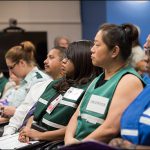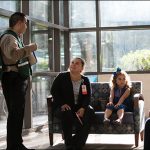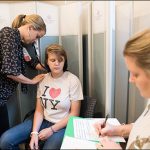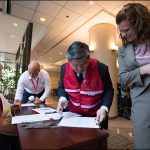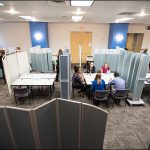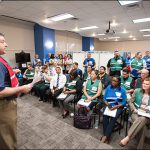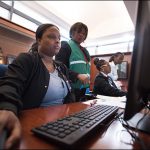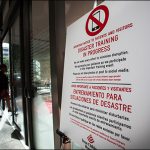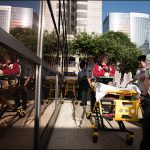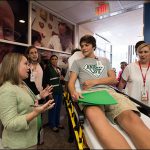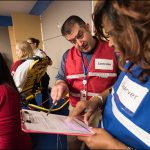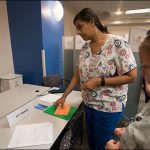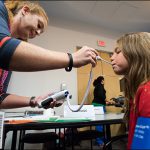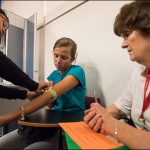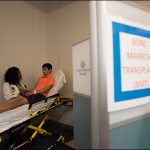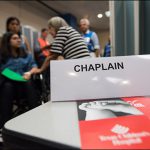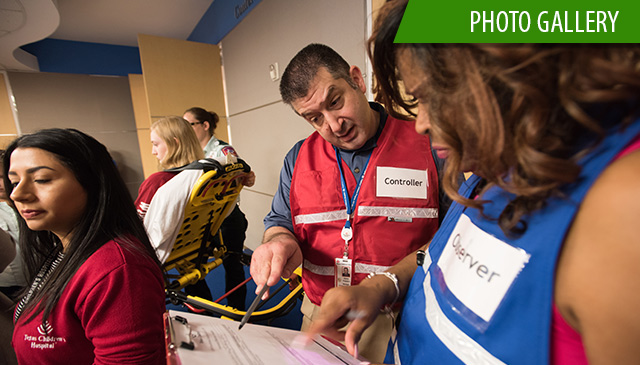 Texas Children’s Hospital’s Emergency Management and Bone Marrow Transplant teams recently conducted their first large scale functional radiation injury treatment exercise. As a member of the Radiation Injury Treatment Network (RITN), our organization conducts annual exercises as part of our emergency preparedness activities.
Texas Children’s Hospital’s Emergency Management and Bone Marrow Transplant teams recently conducted their first large scale functional radiation injury treatment exercise. As a member of the Radiation Injury Treatment Network (RITN), our organization conducts annual exercises as part of our emergency preparedness activities.
“This was new for us. We’ve never done an exercise on this scale,” said manager of the Emergency Management department, Aaron Freedkin. “Normally, we just do our own internal tabletop exercise, last year was a regional tabletop, and this year we wanted to make ours a large and more complex functional exercise.”
RITN is a system of hospitals affiliated with the National Marrow Donor Program providing comprehensive evaluation and treatment for victims of radiation exposure or other bone marrow toxic injuries.
This year’s exercise was a simulation of the arrival of 30 patients to the Medical Center Campus, six patients to Woodlands, and six patients to West Campus, that are victims of a terrorist event. The scenario starts two weeks after a nuclear explosion in Los Angeles and the victims are all suffering from acute radiation syndrome. The patients that are coming to Texas Children’s are in need of a bone marrow transplant or specialized supportive medical care.
To prevent overcrowding the Emergency Center, a Patient Reception Center (PRC) for the exercise was created in the first floor auditorium of Feigin Tower. Several supportive care staff were positioned strategically for the arrival of victims. Conference rooms at West and Woodlands Campuses were also set-up to simulate a reception center.
“You can kind of call it a stress test for how our hospital’s going to deal with an influx of real patients. It’s really a medical surge exercise for us,” Freedkin said. “We’ve done it with mass casualties where we’ve simulated a bus crash or a terrorist event for the ER, but we’ve never done something quite on this scale and in this vein.”
Prior to the exercise, the team had a quick introductory briefing to make sure everyone knew their roles. The simulation then began with patients arriving, some even on gurneys as they would possibly be during a real event. Upon arriving, patients and their family members or guardians received a preliminary health check for safety precautions before visiting with Patient Experience to offer comfort and any necessary information needed along with Language Services to assist with any language barriers.
“They are scanned for radiation contamination so that the Communications Team can make sure all of our current staff and patients who are in the hospital know we are ensuring there’s no risk from these patients arriving,” Freedkin said. There’s a lack of understanding among the general public about the difference between contamination and exposure to radiation. So they definitely would go and get checked first.”
The initial step of the process was registration before the patient and their family members were escorted through triage. They then met with a physician for a simulated exam, followed by a simulated blood drawing session. Texas Children’s Patient and Family Services departments such as Social Work, Chaplaincy, and Child Life were also available to offer patients whatever kind of support they needed. This is very important because in a real event they would have been taken from a familiar environment where the incident happened, to an unknown field hospital, and possibly even another level of care before arriving at Texas Children’s.
“They might not know where all their family is. They might not know who survived. There’s some big emotional issues there,” Freedkin said. “They might not have any belongings either. We’re going to bring them here and make sure that we’re meeting all of their physical and emotional needs.”
The simulation ended after the last patient went through the entire process successfully. Essentially, they would have gotten all of the stations checked off on their card, then transferred to a patient care room if necessary.
“The exercise was very successful in testing our PRC,” Freedkin added. The PRC was a new concept that we developed to allow the hospital to process a surge of patients into the hospital without putting stress on the Emergency Center.”
For next year the teams hope to do a more complex full scale exercise where they would be able to move a larger number of patients to and from Ellington Field, a local military airport, and create a greater simulation to possibly include other outside emergency services such as the fire department, state entities, and federal agencies.
“I look forward to seeing how the lessons learned from this exercise improve the process for the next time that we simulate it,” Freedkin said. “It’s something we hope never happens, but it’s something that we need to be prepared for and be able to support if something really does happen. In the big picture, it helps us with overall preparedness that we can use the lessons here to manage any large scale surge event.”


